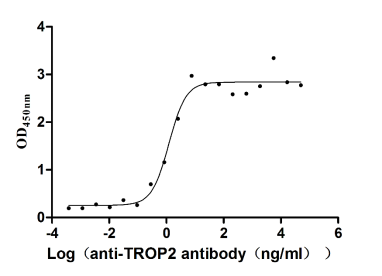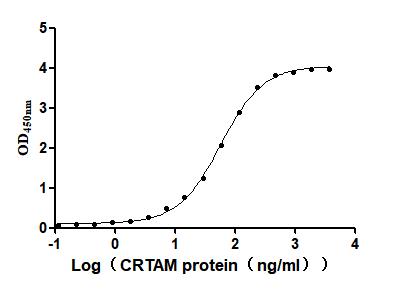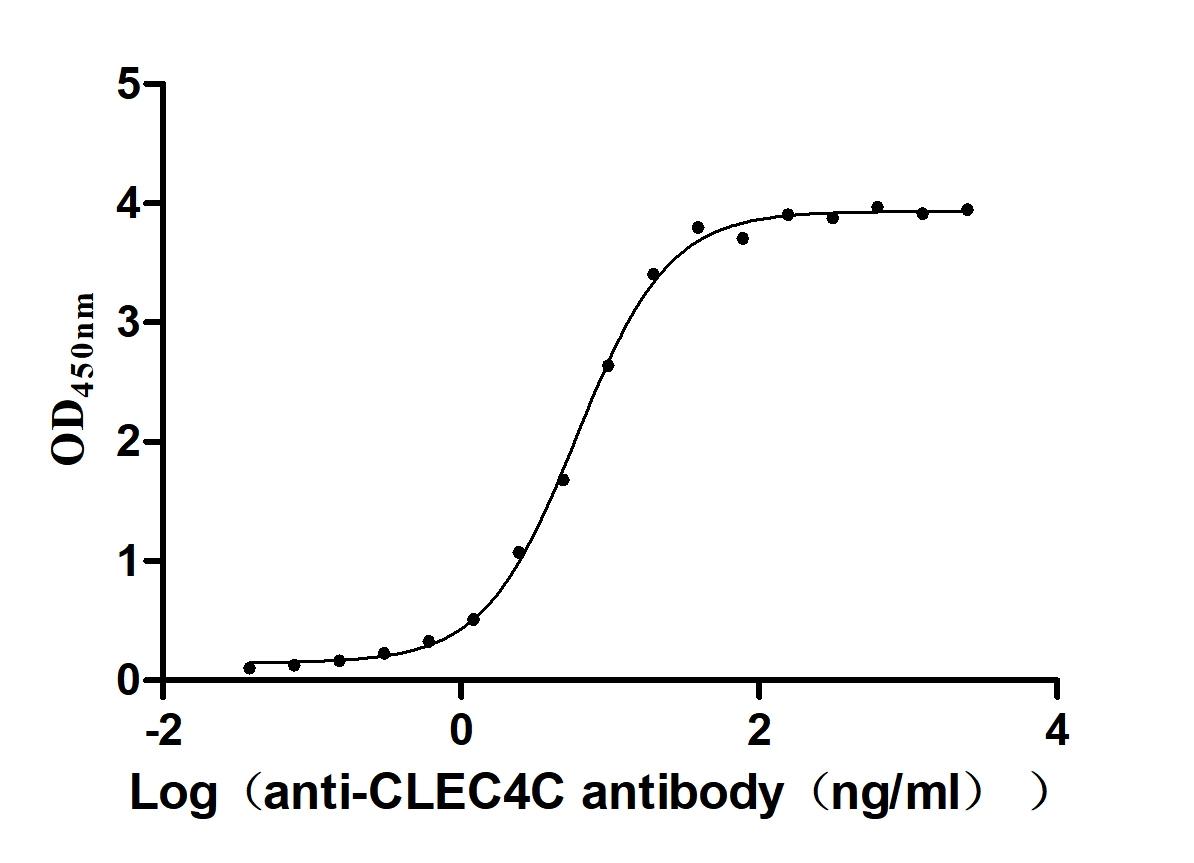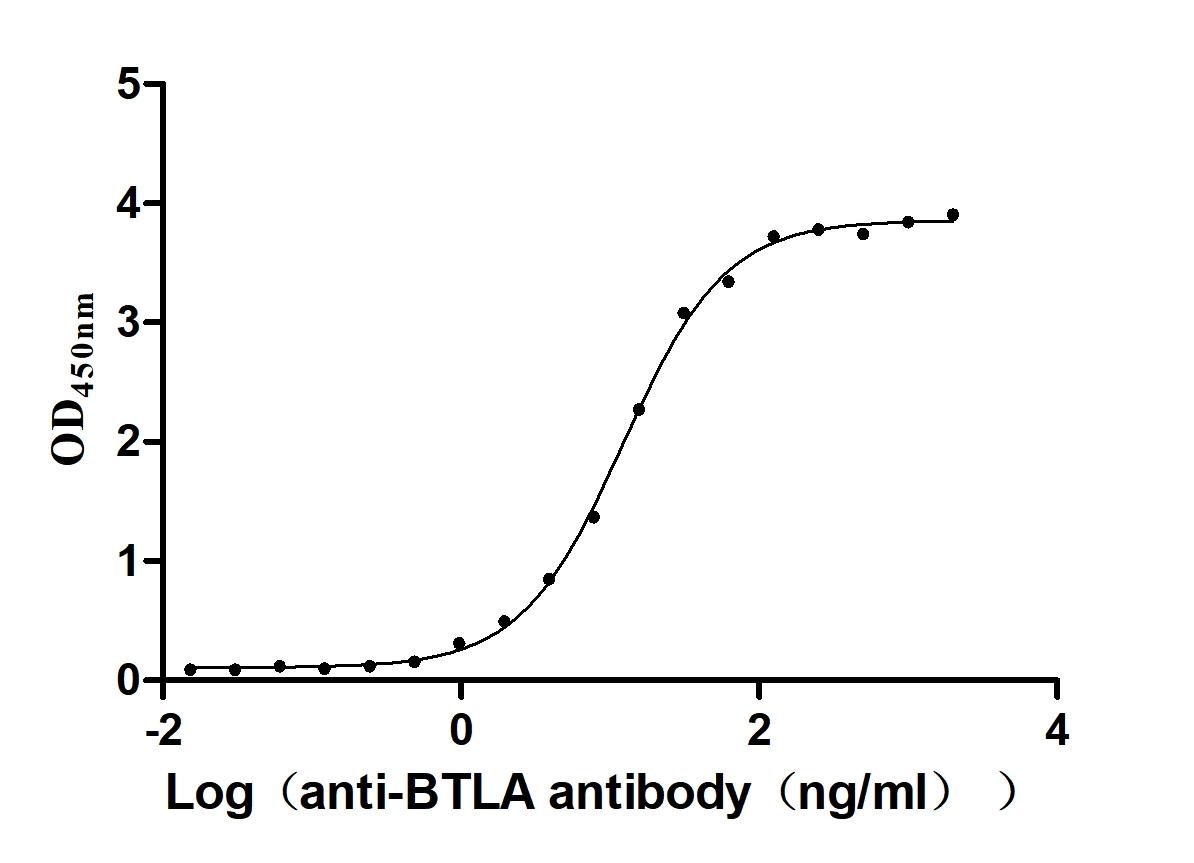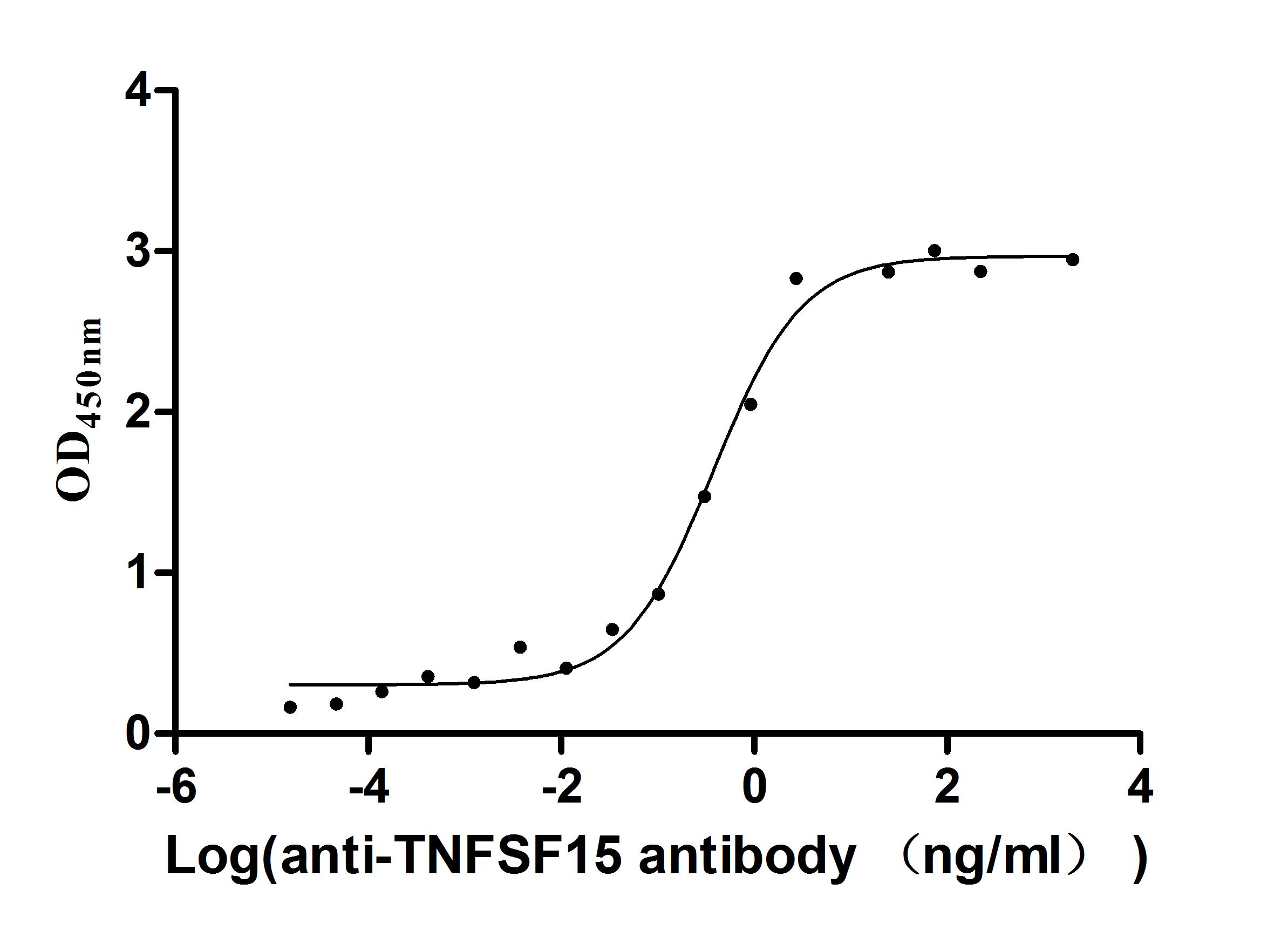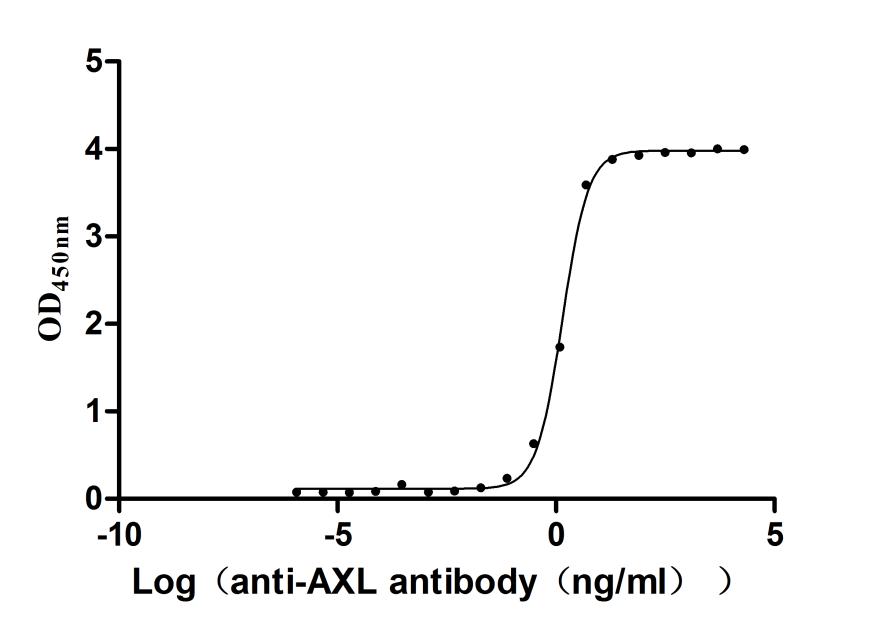Recombinant Human Cell migration-inducing and hyaluronan-binding protein (CEMIP), partial
-
中文名称:Recombinant Human Cell migration-inducing and hyaluronan-binding protein (CEMIP), partial
-
货号:CSB-EP845143HU3
-
规格:¥2328
-
图片:
-
其他:
产品详情
-
纯度:Greater than 90% as determined by SDS-PAGE.
-
生物活性:Not Test
-
基因名:CEMIP
-
Uniprot No.:
-
种属:Homo sapiens (Human)
-
蛋白长度:Partial
-
来源:E.coli
-
分子量:42.7 kDa
-
表达区域:31-350aa
-
氨基酸序列TVAAGCPDQSPELQPWNPGHDQDHHVHIGQGKTLLLTSSATVYSIHISEGGKLVIKDHDEPIVLRTRHILIDNGGELHAGSALCPFQGNFTIILYGRADEGIQPDPYYGLKYIGVGKGGALELHGQKKLSWTFLNKTLHPGGMAEGGYFFERSWGHRGVIVHVIDPKSGTVIHSDRFDTYRSKKESERLVQYLNAVPDGRILSVAVNDEGSRNLDDMARKAMTKLGSKHFLHLGFRHPWSFLTVKGNPSSSVEDHIEYHGHRGSAAARVFKLFQTEHGEYFNVSLSSEWVQDVEWTEWFDHDKVSQTKGGEKISDLWKAH
Note: The complete sequence including tag sequence, target protein sequence and linker sequence could be provided upon request. -
蛋白标签:C-terminal 6xHis-tagged
-
产品提供形式:Liquid or Lyophilized powder
Note: We will preferentially ship the format that we have in stock, however, if you have any special requirement for the format, please remark your requirement when placing the order, we will prepare according to your demand. -
缓冲液:If the delivery form is liquid, the default storage buffer is Tris/PBS-based buffer, 5%-50% glycerol. If the delivery form is lyophilized powder, the buffer before lyophilization is Tris/PBS-based buffer, 6% Trehalose.
-
复溶:We recommend that this vial be briefly centrifuged prior to opening to bring the contents to the bottom. Please reconstitute protein in deionized sterile water to a concentration of 0.1-1.0 mg/mL.We recommend to add 5-50% of glycerol (final concentration) and aliquot for long-term storage at -20℃/-80℃. Our default final concentration of glycerol is 50%. Customers could use it as reference.
-
储存条件:Store at -20°C/-80°C upon receipt, aliquoting is necessary for mutiple use. Avoid repeated freeze-thaw cycles.
-
保质期:The shelf life is related to many factors, storage state, buffer ingredients, storage temperature and the stability of the protein itself.
Generally, the shelf life of liquid form is 6 months at -20°C/-80°C. The shelf life of lyophilized form is 12 months at -20°C/-80°C. -
货期:Delivery time may differ from different purchasing way or location, please kindly consult your local distributors for specific delivery time.
-
注意事项:Repeated freezing and thawing is not recommended. Store working aliquots at 4℃ for up to one week.
-
Datasheet & COA:Please contact us to get it.
相关产品
靶点详情
-
功能:Mediates depolymerization of hyaluronic acid (HA) via the cell membrane-associated clathrin-coated pit endocytic pathway. Binds to hyaluronic acid. Hydrolyzes high molecular weight hyaluronic acid to produce an intermediate-sized product, a process that may occur through rapid vesicle endocytosis and recycling without intracytoplasmic accumulation or digestion in lysosomes. Involved in hyaluronan catabolism in the dermis of the skin and arthritic synovium. Positively regulates epithelial-mesenchymal transition (EMT), and hence tumor cell growth, invasion and cancer dissemination. In collaboration with HSPA5/BIP, promotes cancer cell migration in a calcium and PKC-dependent manner. May be involved in hearing.
-
基因功能参考文献:
- the in-vitro anti-proliferative and pro-apoptotic effects in colorectal cancer cells that were induced by silencing cell migration inducing hyaluronan binding protein may be associated with GRP78 repression and UPR attenuation PMID: 29024602
- CEMIP expression was increased in retinoblastoma tissues and cells. miR-140-5p inhibited CEMIP expression possibly by targeting the 3'-UTR. PMID: 29808799
- KIAA1199 is overexpressed in pancreatic intraepithelial neoplasia. PMID: 27922049
- Our findings revealed that KIAA1199 protein could be applied in predicting nonsmall cell lung cancer patient's outcome PMID: 28901311
- Overexpression of KIAA1199 may contribute to increased migration of pancreatic ductal adenocarcinoma cells and predict shorter survival after surgical resection. PMID: 28012880
- Results suggest a possible link between inflammation, induced KIAA1199 expression, and enhanced migration during pancreatic ductal adenocarcinoma (PDAC) progression. PMID: 28179576
- Elevated KIAA1199 protein expression is associated with tumor invasion and metastasis in colorectal cancer. PMID: 28213952
- KIAA1199 promotes migration and invasion by Wnt/beta-catenin pathway and matrix metalloproteinase-mediated epithelial-mesenchymal transition progression, and serves as a poor prognosis marker in gastric cancer. PMID: 28422983
- CEMIP directly facilitates colon tumor growth, and high CEMIP expression correlates with poor outcome in stage III and in stages II+III combined cohorts. PMID: 26437221
- Results provide insight into the upregulation of CEMIP within cancer and can lead to novel treatment strategies targeting this cancer cell migration-promoting gene. PMID: 26009875
- We present evidence that high expression of KIAA1199 is associated with tumor invasion depth, TNM stage, and poor prognosis in colorectal cancer PMID: 26045799
- Regulation of Hyaluronan (HA) Metabolism Mediated by HYBID (Hyaluronan-binding Protein Involved in HA Depolymerization, KIAA1199) and HA Synthases in Growth Factor-stimulated Fibroblasts. PMID: 26518873
- oncogenic protein induced by HPV infection and constitutive NF-kappaB activity that transmits pro-survival and invasive signals through EGFR signalling PMID: 25366117
- KIAA1199 plays an important role in glycogen breakdown and cancer cell survival PMID: 25051373
- KIAA1199 influences the proliferation, adhesion, motility, invasiveness and epithelial-to-mesenchymal transition of cancer cells, is a likely target gene of the Wnt/beta-catenin signalling pathway[review] PMID: 24573670
- Findings indicate that KIAA1199 may play an important role in breast tumor growth and invasiveness. PMID: 24628760
- proteins that might interact with KIAA1199 and molecular pathways in which it might play roles, were identified. PMID: 23936024
- Results suggest that the N-terminal portion of KIAA1199 functions as a cleavable signal sequence required for proper KIAA1199 translocation and KIAA1199-mediated HAhyaluronan depolymerization. PMID: 24269685
- KIAA1199 serves as a novel cell migration-promoting gene and plays a critical role in maintaining cancer mesenchymal status. PMID: 23990668
- KIAA1199 is a new hyaluronan binding protein involved in hyaluronan depolymerization. PMID: 23509262
- KIAA1199 is differentially expressed in neoplastic tissues and KIAA1199 transcripts are more abundant in the plasma of patients with either cancer or adenoma compared to controls. PMID: 22276102
- KIAA1199 transcript and protein are highly expressed in the majority of CRCs. KIAA1199 probably participates in Wnt-signalling, affecting cell proliferation, motility, adhesion. Also, KIAA1199 has a clinical correlation to outcome in stage-II CRC patients PMID: 21772334
- KIAA1199 is upregulated in gastric adenocarcinoma and is associated with tumor progression. PMID: 21443102
- three possibly disease-causing point mutations PMID: 14577002
- KIAA1199 was highly expressed in gastric cancer, and was associated with prognosis and lymph node metastasis in multivariate analyses. Taken together, KIAA1199 may be a novel gene that plays an important role in progression of gastric cancer. PMID: 19434458
显示更多
收起更多
-
亚细胞定位:Nucleus. Cytoplasm. Endoplasmic reticulum. Cell membrane. Membrane, clathrin-coated pit. Secreted. Note=Retained in the endoplasmic reticulum (ER) in a HSPA5/BIP-dependent manner. Colocalized with clathrin heavy chain/CLTC in clathrin-coated vesicles. Strongly detected in the cytoplasm of breast carcinoma cells, whereas poorly detected in adjacent normal epithelial cells, stromal cells, or benign breast tissues. Localized in the nucleus and cytoplasm of colon adenocarcinomas.
-
蛋白家族:TMEM2 family
-
组织特异性:Expressed in dermal and in synovial fibroblasts. Strongly expressed in gastric cancers compared with the paired normal tissues. Strongly expressed in both ductal carcinoma and invasive breast cancer cells compared with benign epithelial cells (at protein
-
数据库链接:
Most popular with customers
-
Recombinant Human Microtubule-associated protein tau (MAPT) (Active)
Express system: Mammalian cell
Species: Homo sapiens (Human)
-
Recombinant Human Tumor-associated calcium signal transducer 2 (TACSTD2), partial (Active)
Express system: Mammalian cell
Species: Homo sapiens (Human)
-
Recombinant Mouse Cytotoxic and regulatory T-cell molecule (Crtam), partial (Active)
Express system: Mammalian cell
Species: Mus musculus (Mouse)
-
Recombinant Macaca fascicularis C-type lectin domain family 4 member C(CLEC4C), partial (Active)
Express system: Mammalian cell
Species: Macaca fascicularis (Crab-eating macaque) (Cynomolgus monkey)
-
Recombinant Human B- and T-lymphocyte attenuator(BTLA), partial (Active)
Express system: Mammalian cell
Species: Homo sapiens (Human)
-
Recombinant Human Cadherin-6(CDH6),partial (Active)
Express system: Mammalian cell
Species: Homo sapiens (Human)
-
Express system: Mammalian cell
Species: Homo sapiens (Human)
-
Recombinant Human Tyrosine-protein kinase receptor UFO(AXL),partial (Active)
Express system: Mammalian cell
Species: Homo sapiens (Human)

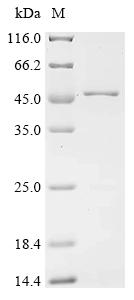

-AC1.jpg)
